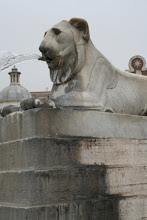After completing week
two of my course, I headed down the Via Nazionale to visit the national museum,
the Palazzo Massimo, late last week. I was particularly was interested in seeing the frescoes
from the Villa of Livia, wife of Augustus – the emperor who ruled after Julius
Caesar and famously changed Rome from a city of brick, to one of marble.
Livia Drusilla has always been a shadowy historical figure –
devoted third wife of Augustus, mother of the dreadful Tiberius, staunch
upholder of the family values instigated on the Roman populace by her husband. In her house on the Palatine Hill - rarely
open - there are still fragments of mosaic floors and frescoes to give a sense
of the opulence and beauty of her surroundings.
But to experience the refinement and detail of these frescoes,
you can see her Painted Garden, the partly submerged room from her villa on the
outskirts of Rome, at the Palazzo Massimo. Archaeologists believe the room was used as an escape from
the summer heat, and have found evidence of underground water pipes that
probably carried water to a central fountain. With its shadowy greens and blues,
abundant flora and fauna (all seasons are in flower here) it no doubt gave a
beautiful sense of shady coolness and peace.
In the late 1800’s the room was lifted in its entirety from
the Villa of Livia to avoid damaging the frescoes from encroaching damp, and
it was an incredible undertaking to reconstruct the room, to the same
dimensions, on the top floor of the Palazzo Massimo museum. You can sit in the centre of the room, and
look at these 2,000 year old paintings and just wonder at the skill and ability
to render such wonderful perspective by the artists of the day.
See the reconstructed room in this video (with breathy commentary!).
You could happily spend days in the Palazzo museum – and along with
the regular exhibitions, currently there is a special exhibition of Monsters. Fantastic Creatures of Fear and Myth
from the ancient world – the collections of sculpture, jewellery, mosaics and
frescoes are fantastic. But the other
great things to see in this museum are the relics from the ships of Nemi, those
pleasure boats sailed by Caligula in the first century A.D. on the shores of this volcanic lake 30km south
of Rome.
These boats were enormous – 240 feet in length - and the
technology was most advanced for the time. It’s
thought the ships were built solely for recreation, incorporating sculpture,
mosaics, hot and cold bathing, and even rotating platforms. A year after their construction, they were
stripped of their valuables and deliberately sunk after the assassination of
Caligula.
In 1927, a fantastic undertaking to recover the ships
involved draining the volcanic lake into nearby farmlands. Ordered by Mussolini, a combined effort from
the navy, army, industry and private contributions saw the first ship break the
surface of the lake in 1929. By 1931 the
second ship was uncovered; unleashing 500,000 cubic metres of mud and causing
74 acres of the lake floor to subside.
The ships were displayed in a museum on the shores of the
lake, and tragically destroyed in the Second World War by fire, purportedly by the
retreating German army. Some material, stored in Rome, can be seen today in the Palazzo Massimo.
Of particular beauty is the bronze handrail to the first ship, with alternate busts of gods and goddesses. And the incredible medusa head in bronze, so finely worked you can see the flowing lines of the hair, and the lines of the face.





A good day's outing. You're right about the "breathy" voices - not certain which of them is worse. Great video site however (which interestingly the same narrators are less breathy). the frescoes from Livia's villa remind me of those we saw in P
ReplyDelete... Pompei, at what I think was the Villa of Venus.
ReplyDelete